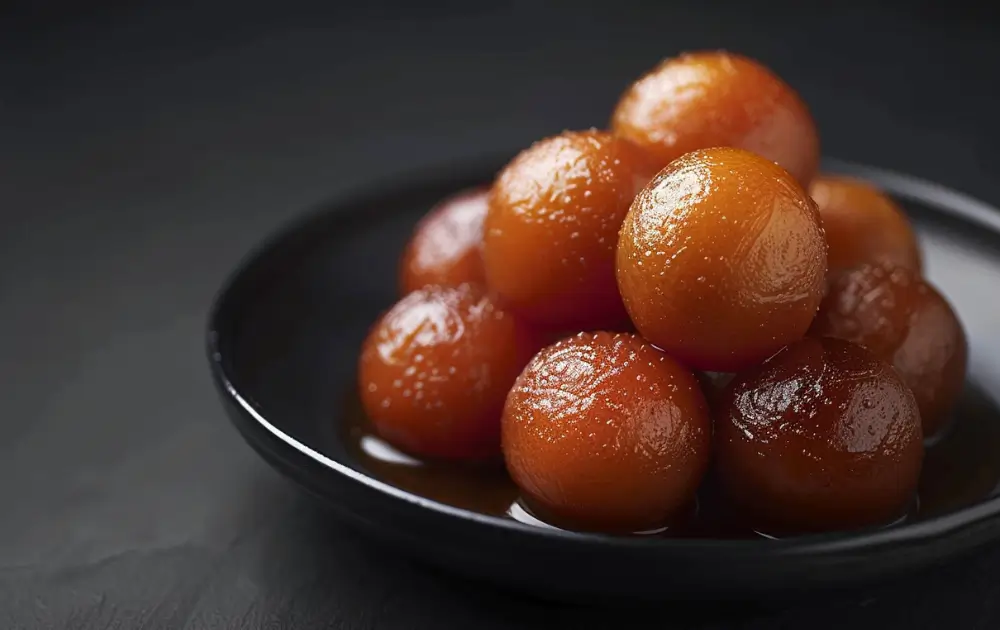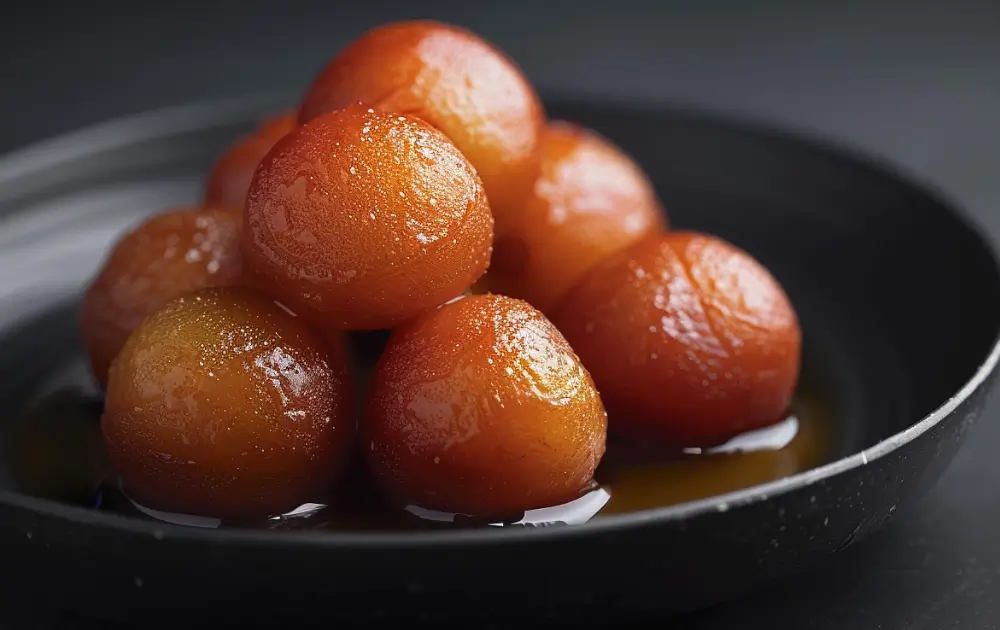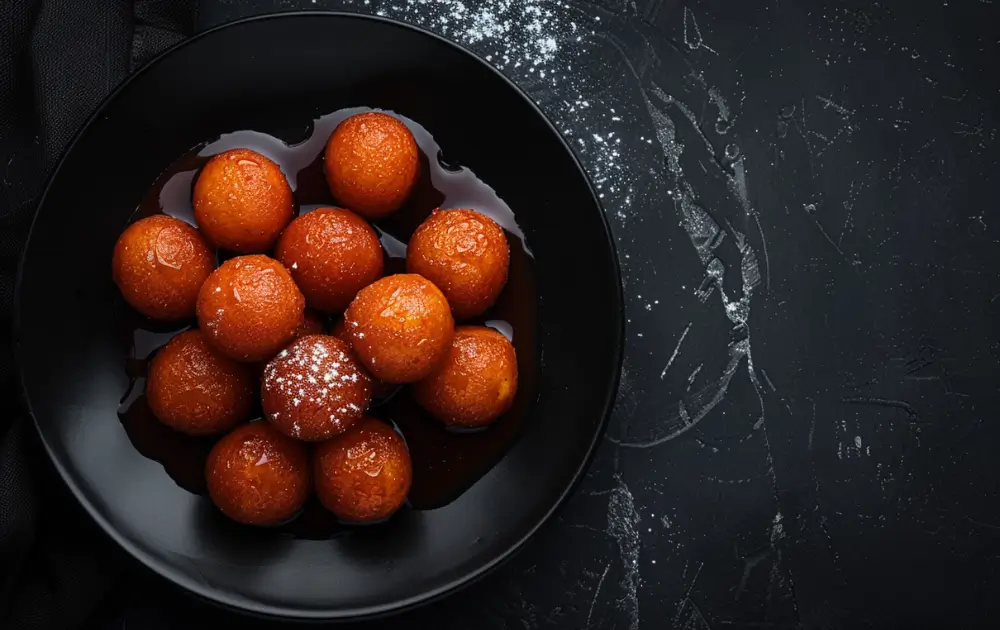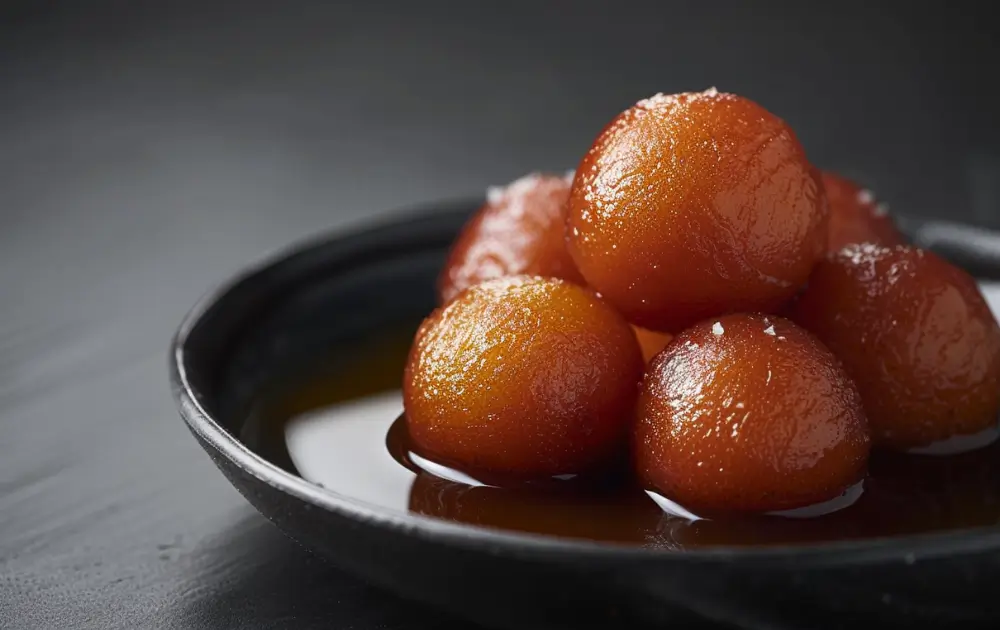Introduction
Gulab Jamun is a classic sweet dish beloved across the Indian subcontinent and among its diaspora. These deep-fried dumplings made from milk solids are traditionally soaked in a sweet, fragrant syrup infused with rose water or cardamom. Often served during festive occasions, weddings, and celebrations, Gulab Jamun’s rich flavor and succulent texture make it a favorite dessert for many. This dessert not only embodies the essence of Indian festivities but also brings a sense of joy and indulgence to every bite.
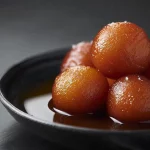
Gulab Jamun
- Total Time: 50 minutes
- Yield: 20-25 pieces
- Diet: Vegetarian
Description
Gulab Jamun is a popular Indian dessert consisting of soft, spongy balls made from milk solids (khoya) and flour, deep-fried and then soaked in a sweet, fragrant syrup often flavored with cardamom, rose water, or saffron. This dessert is a staple at festive occasions and is cherished for its rich, sweet flavor.
Ingredients
- For Sugar Syrup:
- For Gulab Jamun Dough:
- For Frying:
Instructions
Notes
- Ensure the oil is not too hot, as the jamuns will brown on the outside but remain uncooked inside.
- The balls expand in size when fried and soaked, so make smaller sized balls to start.
- If the dough is too dry, add a little milk. If too sticky, add a bit more flour.
- Prep Time: 20 minutes
- Cook Time: 30 minutes
- Category: Dessert
- Method: Frying
- Cuisine: Indian
Nutrition
- Calories: 150
- Sugar: 15g
- Sodium: 10mg
- Fat: 7g
- Carbohydrates: 20g
- Protein: 2g
- Cholesterol: 20mg
Frequently Asked Questions
- What is Gulab Jamun made of? it is primarily made from khoya, which is milk reduced to a solid mass, mixed with flour and a leavening agent, then deep-fried and soaked in a sweet syrup flavored with rose water, cardamom, or saffron.
- Can I make Gulab Jamun using milk powder instead of khoya? Yes, milk powder combined with flour and a little ghee can be used as a substitute for khoya to make this dessert. This alternative is popular for its convenience and consistent results.
- How long can I store Gulab Jamun? it can be stored in its syrup in the refrigerator for up to one week. For longer storage, they can be kept in the freezer for up to three months.
- Why do my Gulab Jamun sometimes turn hard? it can turn hard if the dough is over-mixed or if the milk solids are not well-kneaded. It’s crucial to ensure the dough is smooth and soft without being too tight or overworked.
- Can Gulab Jamun be made vegan? Yes, for a vegan version, you can use vegan milk solids made from almond or soy milk and replace ghee with coconut oil. Ensure the sugar syrup is made with vegan sugar.
Key Ingredients and Variations
The traditional base of Gulab Jamun includes khoya (milk solids) and all-purpose flour. The khoya is kneaded into a dough, sometimes with a little semolina or bread crumbs for texture, then mixed with flour and a leavening agent to form smooth, firm balls. These are then deep-fried until golden brown before being submerged in warm sugar syrup. Variations include adding saffron to the syrup for an exotic touch or stuffing the dumplings with nuts or dried fruits for added texture and flavor. In some recipes, paneer or sweet potatoes are used as alternatives to khoya, catering to different regional tastes and dietary requirements.
Preparation Techniques
The preparation requires careful attention to the texture of the dough and the temperature of the oil. The dough should be soft yet firm enough to hold its shape without cracking during frying. If it’s too dry, the dumplings will harden; if too moist, they will break apart in the oil. The oil itself must be meticulously maintained at a medium heat. Too hot, and the dumplings will brown on the outside but remain uncooked inside; too cool, and they will absorb excess oil and become greasy. Achieving the perfect balance is key to creating soft, succulent Gulab Jamuns.
Serving and Presentation
Gulab Jamun is typically served warm or at room temperature, often garnished with dried nuts like pistachios or almonds to add a crunch that contrasts the softness of the dumplings. It can be presented in individual bowls or as part of a larger dessert spread. During the colder months, Gulab Jamun is sometimes paired with a scoop of vanilla ice cream, offering a delightful hot-and-cold culinary experience. In more formal settings, the dessert can be decorated with edible silver leaf, a common practice in South Asian desserts to enhance aesthetic appeal and signify luxury.
Cultural Significance and Popularity
Gulab Jamun holds a special place in South Asian culinary heritage, often served during major festivals such as Diwali, Eid, and weddings. The dessert’s popularity transcends regional and religious boundaries, making it a symbol of celebration and joy. Its presence on the menu is often a sign of hospitality and generosity, deeply rooted in the tradition of sharing sweets with guests as a gesture of welcome. The universal appeal of Gulab Jamun has led to its adaptation into other forms of sweets, such as cakes, pastries, and even ice creams, showcasing its versatility and enduring popularity in the culinary world.
Nutritional Considerations
While Gulab Jamun is a delightful treat, it is high in sugars and fats, which should be consumed in moderation, particularly by those monitoring their calorie intake or with dietary restrictions. Each dumpling is rich in carbohydrates primarily from the sugar and the milk solids. For a healthier alternative, some chefs use sweeteners like jaggery instead of refined sugar, or incorporate whole wheat flour instead of all-purpose flour to increase the fiber content. Additionally, experimenting with baking instead of deep-frying can significantly reduce the oil content, offering a lighter version of this traditional sweet. However, traditionalists might argue that these modifications alter the essential qualities of the dish.
Storage and Shelf Life
Proper storage of Gulab Jamun is crucial for maintaining its taste and texture. Once prepared, Gulab Jamun can be stored in its syrup in airtight containers to keep them moist and delicious. In the refrigerator, they can last for up to a week. For longer storage, Gulab Jamun can be frozen without the syrup for up to six months; they should be thawed and reheated gently, preferably in a simmering syrup, before serving. It is important to ensure that the syrup covers the dumplings entirely to prevent them from drying out.
Festive Serving Ideas
Gulab Jamun is often featured in festive meals, making its presentation important. During festive times, it is common to serve Gulab Jamun in decorative bowls or trays that complement the rich and vibrant aesthetics of the occasion. Adding a touch of luxury with garnishes such as gold leaf, saffron strands, or rose petals can make the dessert stand out even more. For a modern twist, some chefs create Gulab Jamun parfait layers with cream and crushed pistachios, or Gulab Jamun cheesecakes, merging traditional flavors with contemporary dessert forms.
Pairing with Beverages
To complement its sweetness, Gulab Jamun can be paired with a variety of beverages. A common pairing is with masala chai, which offers a spicy contrast to the sweet, syrupy flavors of the dessert. In a more formal setting, a sweet dessert wine or a light sparkling wine can elevate the dining experience. For those looking for a non-alcoholic option, a spiced or herbed lassi can provide a refreshing and palate-cleansing counterpart to the rich dessert, balancing the overall flavor profile.
Adapting for International Cuisines
As Gulab Jamun continues to cross culinary borders, chefs around the world adapt the recipe to suit local tastes and available ingredients. In fusion cuisine, Gulab Jamun might be served with fruit compotes or citrus zest to introduce a tangy element that cuts through the sweetness. Some international dessert cafes serve Gulab Jamun with coffee or incorporate them into ice cream sundaes, combining South Asian flavors with Western dessert concepts. This versatility not only introduces Gulab Jamun to a global audience but also showcases its potential to be adapted and enjoyed in numerous innovative ways.
Exploring Gluten-Free and Vegan Options
To accommodate dietary restrictions, Gulab Jamun can be adapted to be both gluten-free and vegan. Replace traditional khoya and flour with gluten-free flour blends and use almond or soy milk solids to create a vegan version of the dumplings. Instead of using regular dairy products, opt for vegan butter and plant-based milks in the dough and syrup. These adaptations require careful balancing to maintain the desired texture and flavor, but they open up the dessert to those avoiding gluten or animal products, ensuring everyone can enjoy this classic treat.
Innovative Cooking Methods
Experimenting with different cooking methods can transform the traditional preparation of Gulab Jamun. Instead of deep-frying, try air-frying or baking the dumplings to reduce the oil content significantly. These methods not only make the dessert healthier but also easier to prepare in a home kitchen. Using an air fryer, in particular, can achieve a crisp exterior without the heaviness of oil, while baking can provide a softer but equally delicious texture.
Seasonal Flavor Variations
Introduce seasonal flavors into Gulab Jamun to refresh the traditional recipe throughout the year. For autumn, mix in pumpkin spice or apple cinnamon into the dough or syrup for a warm, seasonal taste. During the winter holidays, adding peppermint or gingerbread spices can offer a festive twist. Spring variations could include lemon zest or berry-infused syrup, bringing brightness and freshness to the dish. These seasonal variations not only make the dessert more versatile but also more appealing to a broader audience.
Culinary Education Workshops
Hosting culinary workshops focused on making Gulab Jamun can be a great way to share this traditional dessert with others. These workshops can teach various techniques, from the basic preparation of the dough and syrup to more advanced topics like creating vegan or gluten-free versions. Participants can also learn about the cultural significance of Gulab Jamun and how to incorporate modern twists. Such educational experiences are valuable for both novice cooks and seasoned chefs looking to expand their dessert repertoire.
Promotional Strategies for Restaurants
Restaurants offering Gulab Jamun can use creative promotional strategies to highlight this dessert. Feature it in tasting menus or pair it with signature cocktails for a unique dining experience. During specific festivals or holidays, offer special promotions or limited-time flavors to draw in customers. Social media campaigns showcasing the making of Gulab Jamun can also generate interest and attract customers eager to try authentic or innovative takes on traditional Indian sweets. Through these strategies, restaurants can enhance their dessert offerings and create memorable dining experiences for their patrons.

